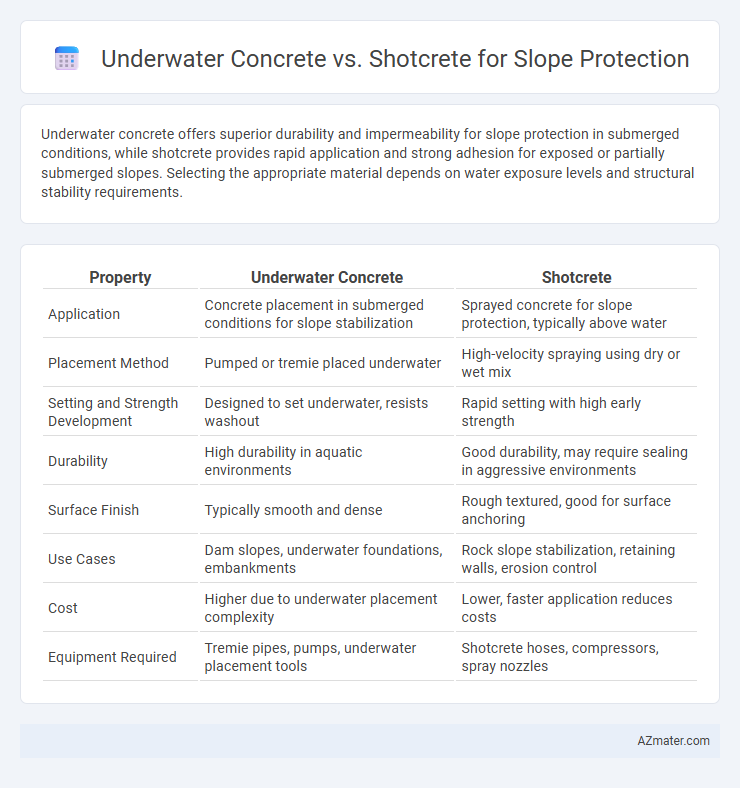Underwater concrete offers superior durability and impermeability for slope protection in submerged conditions, while shotcrete provides rapid application and strong adhesion for exposed or partially submerged slopes. Selecting the appropriate material depends on water exposure levels and structural stability requirements.
Table of Comparison
| Property | Underwater Concrete | Shotcrete |
|---|---|---|
| Application | Concrete placement in submerged conditions for slope stabilization | Sprayed concrete for slope protection, typically above water |
| Placement Method | Pumped or tremie placed underwater | High-velocity spraying using dry or wet mix |
| Setting and Strength Development | Designed to set underwater, resists washout | Rapid setting with high early strength |
| Durability | High durability in aquatic environments | Good durability, may require sealing in aggressive environments |
| Surface Finish | Typically smooth and dense | Rough textured, good for surface anchoring |
| Use Cases | Dam slopes, underwater foundations, embankments | Rock slope stabilization, retaining walls, erosion control |
| Cost | Higher due to underwater placement complexity | Lower, faster application reduces costs |
| Equipment Required | Tremie pipes, pumps, underwater placement tools | Shotcrete hoses, compressors, spray nozzles |
Introduction to Slope Protection Methods
Slope protection methods are critical in preventing soil erosion and stabilizing embankments in marine and river environments. Underwater concrete offers enhanced durability and structural integrity by allowing direct placement beneath water, making it suitable for submerged slopes. Shotcrete provides rapid application through spraying, enabling efficient reinforcement on irregular surfaces but may require additional measures to ensure long-term resistance to underwater conditions.
What is Underwater Concrete?
Underwater concrete is a specialized type of concrete designed to be placed and cured underwater without losing its structural integrity or washout resistance. It typically contains anti-washout admixtures and is formulated with a low slump to prevent segregation and dispersion of cement particles during underwater placement. This makes underwater concrete ideal for slope protection in submerged environments, ensuring durability and stability against erosion and water currents.
Overview of Shotcrete for Slope Protection
Shotcrete is a sprayed concrete method widely used for slope protection due to its strong adhesion, rapid application, and ability to conform to irregular surfaces. It provides effective erosion control and slope stabilization by forming a durable, impermeable layer that resists weathering and water infiltration. Compared to underwater concrete, shotcrete offers faster installation, enhanced flexibility, and minimal environmental disturbance on exposed slopes.
Material Properties: Underwater Concrete vs Shotcrete
Underwater concrete features enhanced anti-washout admixtures and higher cement content, providing superior cohesion and strength retention in submerged conditions compared to shotcrete. Shotcrete, applied pneumatically, offers rapid setting and excellent adhesion on slopes but has lower durability against prolonged water exposure. The material properties of underwater concrete ensure optimal performance in aquatic environments, while shotcrete excels in dry or partially wetted slope protection scenarios.
Installation Techniques and Equipment
Underwater concrete for slope protection is poured using tremie pipes to prevent segregation and ensure stable placement below water, requiring specialized pumps and pipelines designed for submerged environments. Shotcrete involves pneumatically spraying concrete onto slopes using hoses and nozzles, allowing for immediate adhesion and rapid application on irregular surfaces, with equipment including high-pressure air compressors and robotic arms for precise control. Both methods demand tailored machinery and installation techniques to optimize bonding strength and durability in submerged or wet slope conditions.
Durability and Performance in Submerged Conditions
Underwater concrete exhibits superior durability and performance in submerged conditions due to its high resistance to washout and enhanced cohesive properties, making it ideal for long-term slope protection. Shotcrete, while effective for rapid placement and complex geometries, may face challenges with uniformity and adhesion underwater, potentially compromising its durability in continuous submerged exposure. Selecting underwater concrete ensures optimal structural integrity and erosion resistance in aquatic environments, whereas shotcrete suits applications requiring quick stabilization but less prolonged immersion.
Cost Comparison and Budget Considerations
Underwater concrete generally incurs higher costs due to specialized materials, placement techniques, and equipment necessary for submerged environments, making it a premium choice for slope protection in aquatic conditions. Shotcrete offers a more cost-effective solution with faster application and reduced labor expenses, especially suited for slopes above the waterline or in shallow water areas. Budget considerations must factor in project scale, site accessibility, environmental conditions, and long-term durability requirements to select the most economical and effective slope protection method.
Environmental Impact and Sustainability
Underwater concrete minimizes environmental disturbance by reducing turbidity and sediment displacement during placement, making it suitable for aquatic habitats requiring careful ecosystem preservation. Shotcrete offers rapid application and reduced material waste, enhancing sustainability through efficient resource use and lower carbon emissions in slope stabilization projects. Both methods contribute to environmental protection, with underwater concrete excelling in sensitive water environments and shotcrete providing sustainable solutions for exposed slope reinforcement.
Maintenance Requirements and Longevity
Underwater concrete offers superior durability and requires less frequent maintenance due to its dense, low-permeability matrix that resists erosion and chemical attack, making it ideal for long-term slope protection in submerged environments. Shotcrete, while easier and faster to apply on slopes, generally demands more regular inspections and maintenance to address potential cracking and surface degradation caused by environmental exposure. The enhanced longevity of underwater concrete reduces lifecycle costs, whereas shotcrete's maintenance-intensive nature may increase operational expenses over time.
Choosing the Right Solution for Your Project
Choosing between underwater concrete and shotcrete for slope protection depends on site conditions and project goals. Underwater concrete offers superior durability and cohesiveness in submerged environments, preventing erosion and providing long-term stability. Shotcrete excels in rapid application and adaptability on steep or irregular slopes, making it ideal for immediate reinforcement and complex geometries.

Infographic: Underwater concrete vs Shotcrete for Slope protection
 azmater.com
azmater.com